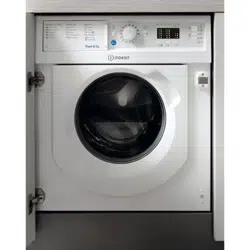Documents: Go to download!
- Owner's manual - (English)
- CONTROL PANEL
- WASH CYCLES
- DAILY USE
- PAUSING A CYCLE
- OPENING THE DOOR, IF NECESSARY
- CHANGING A RUNNING WASH CYCLE
- END OF THE CYCLE
- FUNCTIONS
- CHILD LOCK
- TIPS AND SUGGESTIONS
- CARE AND MAINTENANCE
- LOAD BALANCING SYSTEM
- TROUBLESHOOTING
- CLEANING & MAINTENANCE
Table of contents
USER MANUAL Washing Machine
CONTROL PANEL

- ON/OFF button
- START/PAUSE button with indicator light
- WASH CYCLE PROGRESS indicator lights
- DOOR LOCKED indicator light
- FUNCTION buttons with indicator lights
- CHILDLOCK button with indicator light
- DELAY TIMER button
- SPIN button
- TEMPERATURE button
- WASH CYCLE knob
- PUSH & GO button
WASH CYCLES
| Follow the instructions on the symbols of the garment’s wash care label. The value indicated in the symbol is the maximum recommended temperature for washing the garment. | 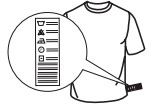 |
Daily cotton
A 30°C cycle for cotton garments. It allows for reducing electricity consumption for heating the water while guaranteeing good washing performance. Suitable for lightly soiled garments.
Daily synthetics
A 30°C cycle for synthetic garments. It allows for reducing electricity consumption for heating the water while guaranteeing good washing results. Suitable for lightly soiled garments.
Coloureds
A 30°C cycle that helps to preserve colours, suitable for cotton or synthetic coloured garments. It allows for reducing electricity consumption for heating the water while guaranteeing good washing results. Suitable for lightly soiled garments.
Delicates
Suitable for washing very delicate garments. It is advisable to turn the garments inside out before washing them. For best results, use liquid detergent on delicate garments. For washing silk items and curtains, select cycle 4 and activate the  option; the machine will end the cycle with the laundry soaked and the indicator light will flash. To drain the water so that the laundry can be removed, press the START/PAUSE
option; the machine will end the cycle with the laundry soaked and the indicator light will flash. To drain the water so that the laundry can be removed, press the START/PAUSE  button or the
button or the  button.
button.
Rapid 30min
For washing lightly soiled garments in a short time. Not suitable for wool, silk and garments to be washed by hand.
Cotton
Suitable for washing towels, underwear, table cloths, etc. made of resistant linen and cotton that are moderately to heavily soiled.
Synthetics
Suitable for washing moderately soiled garments made of synthetic fibres (e.g. polyester, polyacrylic, viscose, etc.) or mixed synthetic-cotton fibres.
Mixed
A 40°C cycle for washing cotton and synthetic garments together. Suitable for lightly soiled underwear.
Eco cotton
Suitable for washing moderately soiled cotton garments. At 40°C and 60°C it is the standard cycle for washing cotton garments, and is the most efficient in terms of combined water and electricity consumption.
White cotton
For heavily soiled whites and resistant colours.
Sport
A cycle designed for washing lightly soiled sports clothing (tracksuits, shorts, etc.); for best results, we recommend not exceeding the maximum load indicated in the “Wash Cycle Table”. We recommend using liquid detergent and adding the amount suitable for a half-load.
Duvet
For washing clothing padded with goose down, such as double or single duvets (weighing under 2 kg), cushions or down jackets. Duvets should be loaded into the drum with their edges folded inwards and no more than ¾ of the total drum volume should be used up. For best results, it is advisable to use liquid detergent to be poured into the detergent drawer.
Wool - Woolmark Apparel Care - Blue: The “Wool” wash cycle is approved by the Woolmark Company for washing wool garments classified as “hand-washable”, provided that the wash complies with the instructions appearing on the garment’s label and with those provided by the manufacturer of this washing machine (M1126). |  |
Anti odour
Use this cycle (for synthetic fabrics) to wash garments with bad odours (e.g. smoke, sweat, fried food). The cycle is designed to remove bad odours while preserving the fabric fibres.
Rinse + Spin
Designed for rinsing and spinning.
Spin + Drain
Designed to spin and drain the water
DAILY USE
Prepare the laundry by following the suggestions appearing under the “TIPS AND SUGGESTIONS” section.
Rapid programming
- Open the door. Load the laundry while making sure not to exceed the maximum load quantity indicated in the cycle table.
- Pull out the detergent dispenser drawer and pour the detergent into the relevant compartments as described in “DETERGENT DISPENSER DRAWER section”.
- Close the door.
- Press the PUSH & GO button to start the wash cycle
Traditional programming
- Turn the washing machine on by pressing the ON/OFF
 button. All the indicator lights will light up for a few seconds, then only the lights corresponding to the settings for the selected wash cycle will remain lit; the START/PAUSE
button. All the indicator lights will light up for a few seconds, then only the lights corresponding to the settings for the selected wash cycle will remain lit; the START/PAUSE  indicator light will also flash.
indicator light will also flash. - Open the door. Load the laundry while making sure not to exceed the maximum load quantity indicated in the Wash Cycle Table.
- Pull out the detergent dispenser drawer and pour the detergent into the relevant compartments as described in “DETERGENT DISPENSER DRAWER” section.
- Close the door.
- Set the WASH CYCLE knob to the desired cycle
- Modify the temperature and/or spin: pressing the
 button allows for gradually reducing the temperature down to the cold wash level (20°C). The spin speed may be progressively reduced by pressing the
button allows for gradually reducing the temperature down to the cold wash level (20°C). The spin speed may be progressively reduced by pressing the  button, until it is completely excluded (the “
button, until it is completely excluded (the “  ” setting. If these buttons are pressed again, the maximum values are restored.
” setting. If these buttons are pressed again, the maximum values are restored. - Select the desired wash cycle.
- Select the desired options.
- Press the START/PAUSE
 button to start the wash cycle; the relative indicator light will light up steady green and the door will lock (
button to start the wash cycle; the relative indicator light will light up steady green and the door will lock ( indicator light on).
indicator light on).
PAUSING A CYCLE
To pause the wash cycle, press the START/PAUSE  button again; the indicator light will flash . If the
button again; the indicator light will flash . If the  indicator light is not lit, the door may be opened. To start the wash cycle from the point at which it was interrupted, press the START/PAUSE
indicator light is not lit, the door may be opened. To start the wash cycle from the point at which it was interrupted, press the START/PAUSE  button again.
button again.
OPENING THE DOOR, IF NECESSARY
Once a cycle starts, the  indicator light turns on to signal that the door cannot be opened. While a wash cycle is running, the door remains locked. To open the door while a cycle is under way, for example, to add or remove garments, press the START/PAUSE
indicator light turns on to signal that the door cannot be opened. While a wash cycle is running, the door remains locked. To open the door while a cycle is under way, for example, to add or remove garments, press the START/PAUSE  button to pause the cycle; the indicator light will flash . If the
button to pause the cycle; the indicator light will flash . If the  indicator light is not lit, the door may be opened. Press the START/PAUSE
indicator light is not lit, the door may be opened. Press the START/PAUSE  button again to continue the cycle.
button again to continue the cycle.
CHANGING A RUNNING WASH CYCLE
To change a wash cycle while it is in progress, pause the washing machine using the START/PAUSE button (the relative indicator light will flash ), then select the desired cycle and press the START/PAUSE
button (the relative indicator light will flash ), then select the desired cycle and press the START/PAUSE  button again.
button again.
! To cancel a cycle that has already begun, press and hold the ON/OFF  button.
button.
The cycle will be stopped and the machine will switch off.
END OF THE CYCLE
Once the cycle terminates the indicator light will light up; when the
indicator light will light up; when the  indicator light switches off, the door may be opened. Open the door, unload the laundry and switch off the machine. If you do not press “ON/ OFF”
indicator light switches off, the door may be opened. Open the door, unload the laundry and switch off the machine. If you do not press “ON/ OFF”  button, the washing machine will switch off automatically after about a half of an hour. Close the water tap, open the door and unload the washing machine. Leave the door ajar to allow the drum to dry.
button, the washing machine will switch off automatically after about a half of an hour. Close the water tap, open the door and unload the washing machine. Leave the door ajar to allow the drum to dry.
FUNCTIONS
- If the selected option is not compatible with the set wash cycle, the indicator light will flash and the option will not be activated.
- If the selected option is not compatible with another previously selected option, the indicator light will flash accompanied by a buzzer, and only the latter option will be activated; the indicator light corresponding to the activated option will turn on.
Stain removal
This option allows for selecting the type of dirt so as to optimally adjust the cycle for removing the stains. The following types of dirt can be selected:
- Food: for stains caused by foodstuffs and beverages, for example.
- Work: for grease and ink stains, for example.
- Outdoor: for mud and grass stains, for example.
Extra rinse
By selecting this option, the efficiency of the rinse is increased and optimal detergent removal is guaranteed. It is particularly useful for sensitive skin.
Easy iron
By selecting this function, the wash and spin cycles will be modified in order to limit the formation of creases. At the end of the cycle the washing machine’s drum will rotate slowly; the EASY IRON and START/ PAUSE indicator lights will flash and the
indicator lights will flash and the  phase will remain lit steady. To end the cycle, press the START/PAUSE
phase will remain lit steady. To end the cycle, press the START/PAUSE button or the EASY IRON button.
button or the EASY IRON button.
Delay start
To set a delayed start for the selected cycle, press the corresponding button repeatedly until the desired delay period has been reached (3h-6h-9h). When the button is pressed for the fourth time, the option will deactivate
Once the START/PAUSE button has been pressed, the delay time can only be modified by decreasing it until the set cycle is launched.
button has been pressed, the delay time can only be modified by decreasing it until the set cycle is launched.
Temperature
Each wash cycle has a pre-defined temperature. To modify the temperature, press the button.
Spin
Each wash cycle has a pre-defined spin speed. To modify the spin speed, press the button.
Push & Go
This function allows for starting a wash cycle even when the machine is switched off without having to press the ON/OFF button in advance or, after switching the machine on, without having activated any other button and/or selector knob (otherwise the Push & Go cycle will be deactivated). To start the Push & Go cycle press and hold the relative button for 2 seconds. The lit indicator light indicates that the cycle has started. This wash cycle is ideal for cotton or synthetic fabrics, as it washes at a temperature of 30°C and a maximum spin speed of 1.000 rpm. Max load 3,5 kg (cycle duration 45’).
How does it work?
1. Load the laundry (cotton and/or synthetic garments) and close the door.
2. Pour the detergent and additives.
3. Start the cycle by pressing and holding the Push & Go button for 2 seconds. The relevant indicator light will turn green and the door will lock (the symbol lights up)
N.B.: starting the wash cycle through the Push & Go button activates an automatic non-customisable cycle recommended for cotton and synthetic fabrics. This cycle does not allow for setting any additional options
To open the door while an automatic cycle is under way, press the START/ PAUSE  button; if the locked door symbol is off, the door may be opened. Press the START/PAUSE
button; if the locked door symbol is off, the door may be opened. Press the START/PAUSE button again to restart the cycle from the point at which it was interrupted.
button again to restart the cycle from the point at which it was interrupted.
4. Once the programme is finished, the indicator light turns on.
indicator light turns on.
CHILD LOCK
to activate the control panel lock, press and hold the button for approximately 2 seconds. The lit symbol signals that the control panel is locked. This prevents wash cycles from being modified accidentally (except for the ON/OFF
button), especially if there are children in the home. To deactivate the control panel lock, press and hold the button for approximately 2 seconds.
TIPS AND SUGGESTIONS
Divide the laundry according to:
Type of fabric (cotton, mixed fibres, synthetics, wool, garments to be hand-washed). Colour (separate coloured garments from whites, wash new coloured garments separately). Delicates (small garments – such as nylon stockings – and items with hooks – such as bras: insert them in a fabric bag)
Empty the pockets:
Objects such as coins or lighters can damage the washing machine and the drum. Check all buttons.
CARE AND MAINTENANCE
Before performing cleaning and maintenance, switch the washing machine off and disconnect it from the mains power. Do not use flammable liquids to clean the washing machine.
Disconnect the water and power supplies
Close the water tap after every wash. This will limit wear on the hydraulic system inside the washing machine and help to prevent leaks. Unplug the washing machine when cleaning it and during all maintenance work.
Clean the washing machine
The outer parts and rubber components of the appliance can be cleaned using a soft cloth soaked in lukewarm soapy water. Do not use solvents or abrasives.
The washing machine has a “Auto-clean” cycle for its internal parts; it must be run without any load in the drum.
To optimise this cycle, it is possible to use either detergent (10% of the quantity specified for lightly soiled garments) or special additives to clean the washing machine. We recommend running a cleaning cycle every 40 wash cycles.
To start the cycle press buttons  and
and  simultaneously for 5 seconds. The cycle will start automatically and will run for about 70 minutes. To stop the cycle, press the START/PAUSE
simultaneously for 5 seconds. The cycle will start automatically and will run for about 70 minutes. To stop the cycle, press the START/PAUSE  button.
button.
Care for the door and drum
Always leave the porthole door ajar in order to prevent unpleasant odours from forming.
LOAD BALANCING SYSTEM
Before every spin cycle, to avoid excessive vibrations before every spin and to distribute the load in a uniform manner, the drum rotates continuously at a speed which is slightly greater than the washing rotation speed. If, after several attempts, the load is not balanced correctly, the machine spins at a reduced spin speed. If the load is excessively unbalanced, the washing machine performs the distribution process instead of spinning. To encourage improved load distribution and balance, we recommend small and large garments are mixed in the load.
TROUBLESHOOTING
The washing machine may occasionally fail to work. Before contacting the Technical Assistance Service, make sure that the problem cannot be easily solved using the following list.
| Anomalies | Possible causes / Solution |
|---|---|
| The washing machine does not start. | The appliance is not plugged into the socket, or not sufficiently to make contact. |
| There is no power in the house. | |
| The wash cycle does not start. | The washing machine door is not closed properly. |
The ON/OFF  button has not been pressed. button has not been pressed. | |
The START/PAUSE  button has not been pressed. button has not been pressed. | |
| The water tap has not been opened. | |
| A delay has been set for the start time | |
| The machine does not fill with water or the indicator light for the first wash cycle stage flashes rapidly. | The water inlet hose is not connected to the tap. |
| The hose is bent. | |
| The water tap has not been opened. | |
| There is no water supply in the house. | |
| The pressure is too low. | |
The START/PAUSE  button has not been pressed. button has not been pressed. | |
| The washing machine continuously loads and unloads water. | The drain hose is not fitted between 65 and 100 cm from the floor. |
| The free end of the hose is immersed in water. | |
The wall drainage system does not have a breather pipe. If the problem persists even after these checks, turn off the water tap, switch the appliance off and contact the Technical Assistance Service. If the home is on one of the upper floors of a building, there may be problems relating to back-siphonage, causing the washing machine to fill with water and drain continuously. Special anti-siphon valves are available in shops and help to prevent this inconvenience. | |
| The washing machine does not drain or spin. | The cycle does not include drainage: with certain cycles it must be started manually. |
| The drain hose is bent. | |
The  option is enabled: to complete the wash cycle, press the START/PAUSE option is enabled: to complete the wash cycle, press the START/PAUSE  button. button. | |
| The drainage duct is clogged. | |
| The washing machine vibrates a lot during the spin cycle. | The drum was not unlocked correctly during installation. |
| The washing machine is not level. | |
| The washing machine is tucked between furniture cabinets and the wall. | |
| The washing machine leaks. | The water inlet hose is not screwed on properly. |
| The detergent dispenser drawer is obstructed. | |
| The drain hose is not properly attached. | |
| The “Options” lights and the START/PAUSE indicator light flash while one of the wash cycle progress and DOOR LOCKED lights are lit in a fixed manner. | Switch off the machine and unplug it, wait for approximately 1 minute and then switch it back on again. If the problem persists, contact the Technical Assistance Service . |
| There is too much foam. | The detergent is not suitable for machine washing (it should be marked with “for washing machine use” or “hand wash and machine wash” or similar). |
| Too much detergent was used. | |
| The Push & Go function does not activate. | After switching on the machine, a control other than Push & Go was activated. Switch the machine off and press the Push & Go button. |
CLEANING & MAINTENANCE
CLEANING THE OUTSIDE OF THE WASHING MACHINE
Use a soft damp cloth to clean the outer parts of the washing machine.
Do not use glass or general purpose cleaners, scouring powder or similar to clean the control panel – these substances might damage the printing.
CHECKING THE WATER SUPPLY HOSE
Check the inlet hose regularly for brittleness and cracks. If damaged, replace it by a new hose available through our After-Sales Service or your specialist dealer. Depending on the hose type:
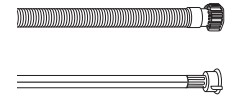
If the inlet hose has a transparent coating, periodically check if the colour intensifies locally. If yes, the hose may have a leak and should be replaced.
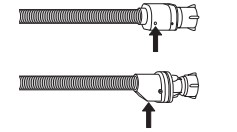
For water stop hoses: check the small safety valve inspection window (see arrow). If it is red, the water stop function was triggered, and the hose must be replaced by a new one. For unscrewing this hose, press the release button (if available) while unscrewing the hose.
CLEANING THE MESH FILTERS IN THE WATER SUPPLY HOSE
1. Close water tap and unscrew the inlet hose.
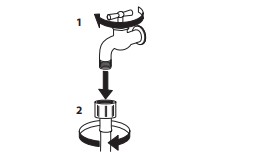
2. Clean the mesh filter at the hose’s end carefully with a fine brush.
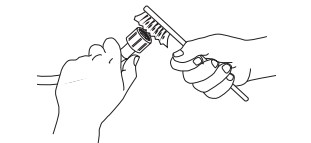
3. Now unscrew the inlet hose on the back of the washing machine by hand. Pull out the mesh filter from the valve on the back of the washing machine with pliers and carefully clean it.
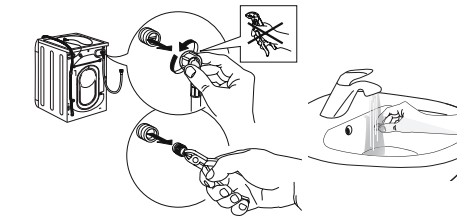
4. Insert the mesh filter again. Connect the inlet hose to water tap and washing machine again. Do not use a tool to connect the inlet hose. Open the water tap and check that all connections are tight.
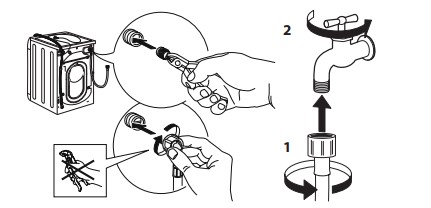
CLEANING THE DETERGENT DISPENSER
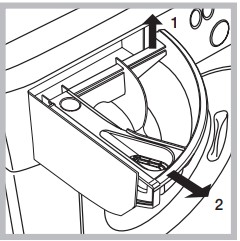 | Remove the dispenser by raising it and pulling it out (see figure). Wash it under running water; this operation should be repeated frequently |
CLEANING THE WATER FILTER / DRAINING RESIDUAL WATER
Switch off and unplug the washing machine before cleaning the water filter or draining residual water. If you used a hot wash programme, wait until the water has cooled down before draining any water.
Clean the water filter regularly, to avoid that the water cannot drain after the wash due to obstruction of the filter. If the water cannot drain, the display indicates that the water filter may be clogged.
1. Container for the drained water: Place a low and wide container under the water filter in order to collect the residual water.
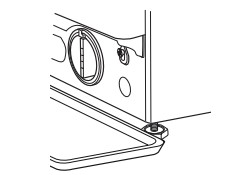
2. Drain the water: Slowly turn the filter counter-clockwise until all the water has come out. Allow the water to flow out without removing the filter. Once the container is full, close the water filter by turning it clockwise. Empty the container. Repeat the procedure until all the water has been drained.

3. Remove filter: Lay a cotton cloth beneath the water filter, which can absorb a small amount of rest water. Then remove the water filter by turning it out anticlockwise.
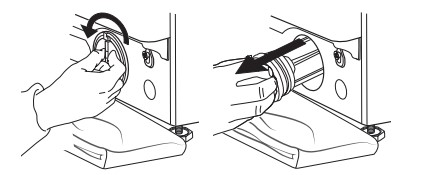
4. Clean the water filter: remove residues in the filter and clean it under running water.

5. Insert the water filter: Reinsert the water filter again by turning it in clockwise direction. Make sure to turn it in as far as it goes; the filter handle must be in vertical position. To test water tightness of the water filter, you can pour about 1 liter of water into the detergent dispenser.
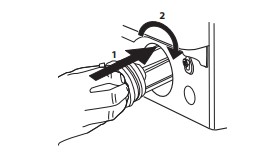
See other models: IWC 71252 ECO UK.M XWD 71252 S UK XWE 91483X S UK BWC 61452 S UK EWE 91482 W UK
